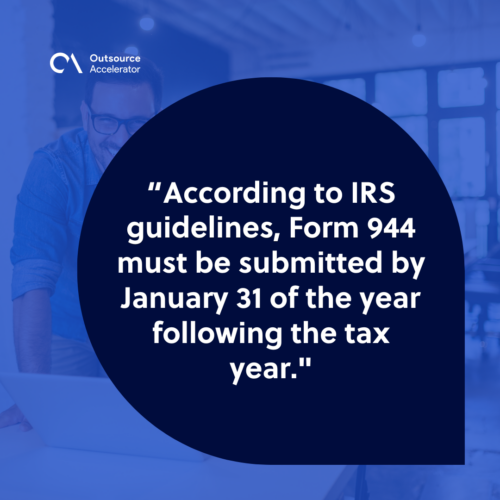IRS Form 944: Definition and filing process

Are you a small business owner or an employer looking for a simplified way to report and pay federal employment taxes? Then look no further because IRS Form 944 might just be the solution you need.
Understanding the nuances of Form 944 is indispensable for businesses seeking efficiency and compliance in their tax obligations.
In this article, we look at the essentials of Form 944, explaining its purpose, requirements, and the steps you need to take to complete it accurately.
What is IRS Form 944?
Form 944 is the “Employer’s Annual Federal Tax Return,” used by eligible small businesses to report their annual federal payroll taxes.
Form 944 offers a simplified alternative to the quarterly filing of Form 941, which is used to report income taxes and payroll taxes withheld from your employees’ wages. It reduces the administrative burden associated with quarterly filings using Form 941.
Small business owners need to understand the eligibility criteria and the specific requirements for this form to ensure accurate and timely compliance.

Why you must file for Form 944
Choosing to file this form allows employers to streamline their tax reporting process and scale down the frequency of paperwork and administrative tasks.
Eligible employers can consolidate their payroll tax reporting responsibilities. This provides a more manageable approach to fulfilling federal tax obligations.
The annual filing requirement aims to ease the compliance burden on small businesses. It’s a more convenient method that also ensures the IRS receives accurate information about the employer’s federal tax liabilities.
Failure to file by the due date may result in penalties and fees from the IRS.
Who must file Form 944?
If you’re a small business owner whose liability for social security, Medicare, and withheld federal income taxes is $1000 or less, you are required to file Form 944. This is the primary criterion.
Employers can refer to their previous tax filings, consult their tax professionals, or use tax software to estimate their liability for the upcoming year.
Certain employers may be exempt from filing Form 944 even if they meet the annual payroll tax liability threshold. This includes newly established businesses and seasonal employers, as determined by the IRS guidelines. Special rules may apply in these cases.
Eligible employers should consistently use Form 944 for annual reporting as long as they meet the criteria. Inconsistencies in reporting or failure to meet eligibility requirements may result in penalties or other consequences.
A prompt switch occurs when businesses transition to Form 941 due to exceeding the $1000 threshold.
Once the threshold is surpassed, the business becomes ineligible for Form 944 for the following tax year and should begin filing Form 941 quarterly.

How to file Form 944
To file Form 944, follow these steps:
1. Determine eligibility
Confirm that your business qualifies to file Form 944 by assessing your annual federal payroll tax liability. You are eligible for annual filing if it is $1,000 or less.
2. Obtain the form
Download the most recent version of Form 944 from the official IRS website. You may also request a copy by calling its local office.
3. Gather information
Collect all the necessary information to fill out your form. This includes:
- Employer Identification Number (EIN)
- Total number of employees
- Wages paid
- Federal income tax withheld
4. Complete the form
Carefully fill out all sections of Form 944, providing accurate information about your business and its payroll tax details. The form includes sections for reporting wages, tips, and other compensation.
5. Calculate tax liability
Use the included worksheet to calculate your total tax liability. Ensure accuracy in your calculations to avoid discrepancies.
6. Check for updates
Be aware of any changes to the form or new IRS instructions. Determine if any adjustments or credits apply to your tax liability and make the necessary changes.
7. Sign and date
Remember to sign and date the form, which will certify its accuracy. Unsigned forms will not be processed.
8. Submit the form
Mail the completed and certified Form 944 to the specified address in your state’s instructions. The IRS does not currently accept electronic filing.
9. Payment of taxes
If you have a tax liability, include payment with your form. Payments can be made electronically through the Electronic Federal Tax Payment System (EFTPS), by check, or through money order.
10. Retain records
Keep a copy of this filed form and supporting documentation for at least four years. This is important in case of an IRS audit or if you need to reference the information later.
This is just a general guide, and it’s advisable to consult the official IRS instructions for filing Form 944. You may also seek professional guidance or use accounting software to assist you.
These resources can provide instructions specific to your business and help navigate any complexities associated with filing federal tax returns.
When to submit Form 944
According to IRS guidelines, Form 944 must be submitted by January 31 of the year following the tax year. This means that businesses must report the previous calendar year’s payroll tax information.

It should be noted that even if your business has no tax liability for the year, you must still file IRS Form 944.
This deadline may vary in certain situations or in cases where it falls on a weekend or holiday. When the deadline is fixed to January 31, you are encouraged to start the preparation process well in advance to allow for any unexpected challenges.
Adherence to the filing timeline and accurate reporting are fundamental aspects of fulfilling your tax obligations. Ultimately, by staying organized and proactively managing your tax responsibilities, you contribute to the smooth running of your business.







 Independent
Independent




